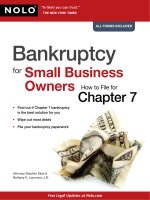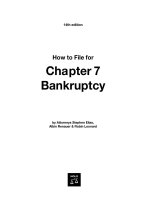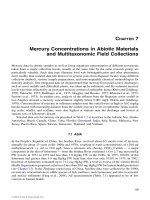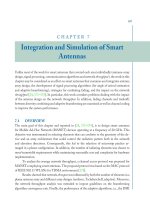Applying career development theory to counseling, 6e chapter 7 and 8
Bạn đang xem bản rút gọn của tài liệu. Xem và tải ngay bản đầy đủ của tài liệu tại đây (75.76 KB, 18 trang )
Chapter 7
SUPER’S MODEL OF THE
CAREER DEVELOPMENT OF CHILDREN
Curiosity
- A basic need
Exploration
- Home, school, everywhere
Information
- Piaget, Erikson
Key figures
- Parents, teachers, public figures
Internal versus external control - Self-control
Development of interests - Fantasies interact with information
Time perspective -
Now versus later
Self concept and planfulness - Sense of self
COPYRIGHT © 2014 Brooks/Cole*Wadsworth Publishing Company A
division of Cengage Inc.
1
PIAGET’S PERIODS OF COGNITIVE
DEVELOPMENT
Sensorimotor (0 to 2) – Infants attend to and respond to objects
and events around them
Preoperational (2 to 7) – Difficulty telling fantasy from reality
Concrete operational (7 to 11) – Think in concrete terms; things
must exist
Formal operational (12 on) – Think abstractly
COPYRIGHT © 2014 Brooks/Cole*Wadsworth Publishing Company A
division of Cengage Inc.
2
IMAGE NORMS
Perceptions of occupational stereotyping
One’s physical self image
Organizational images
(Giannantonio & Hurley-Hanson, 2006)
Pd
COPYRIGHT © 2014 Brooks/Cole*Wadsworth Publishing Company A
division of Cengage Inc.
60
HOWARD AND WALSH’S
LEVELS OF VOCATIONAL REASONING
Level 1 – Pure Association – (age 4) Can give attributes of a job, but
little else
Level 2 – Magical Thinking – Little knowledge about how work is
done or how to enter a profession
Level 3 – External Activities – Choice based on activities, children
participate in activities
COPYRIGHT © 2014 Brooks/Cole*Wadsworth Publishing Company A
division of Cengage Inc.
61
CONCERNS OF ELEMENTARY SCHOOL CHILDREN
Career development concerns are one type of problem
that children encounter at school, others include:
Developmental issues
Learning problems
Neurological problems
Medical issues
Hunger
Unsafe environment
COPYRIGHT © 2014 Brooks/Cole*Wadsworth Publishing Company A
division of Cengage Inc.
Family member’s
substance abuse
Moving to a new
location
Bullying
Isolation
Anger
Delaying satisfaction
5
GOTTFREDSON’S CAREER DEVELOPMENT THEORY
BASIC CONCEPTS
Self-creation theory – How individuals create themselves and
interact with environmental factors such as gender and prestige
Circumscription – Various factors limit career choices at different
ages
Compromise – How an individual modifies choices based on factors
such as competitive jobs and insufficient training
COPYRIGHT © 2014 Brooks/Cole*Wadsworth Publishing Company A
division of Cengage Inc.
6
GOTTFREDSON’S SELF-CREATION THEORY
Internal compass – Based on genetic features and
experiences; guides individuals as
they make choices
Cognitive map of occupations
Compatible – Fits view of oneself
Accessible – Occupations one is likely to pursue
COPYRIGHT © 2014 Brooks/Cole*Wadsworth Publishing Company A
division of Cengage Inc.
7
BLOOM’S TAXONOMY
1.
2.
3.
4.
5.
6.
Remember – Learn facts
Understand – Identify similarities and differences
Apply – Make inferences and decisions
Analyze – Weigh advantages and disadvantages
Evaluate – Make judgments about best decision
Create – Make a plan to reach a goal
COPYRIGHT © 2014 Brooks/Cole*Wadsworth Publishing Company A
division of Cengage Inc.
8
SELF- CREATION OVERVIEW
Interaction of biological and environmental factors
Impact of parents on intellectual ability
Vocational interests affected by interaction of biological and
environmental factors
Nonshared events – Unique, important impact on choices
Genes-Drives-Experience Theory – Role of biological factors on our
development
Internal genetic compass as guide to development
Self-concept – Our continuing developmental view of ourselves
COPYRIGHT © 2014 Brooks/Cole*Wadsworth Publishing Company A
division of Cengage Inc.
9
GOTTFREDSON’S VIEW OF FACTORS AFFECTING
CAREER DEVELOPMENT
Circumscription –
Ideas about gender and prestige influence and
limit career choices.
Compromise –
Career choices are modified due to
environmental and other factors. Individuals give
up interests, prestige, and sex type when
compromising
COPYRIGHT © 2014 Brooks/Cole*Wadsworth Publishing Company A
division of Cengage Inc.
10
GOTTFREDSON’S VIEW OF FACTORS THAT LIMIT OR
CIRCUMSCRIBE VOCATIONAL CHOICE
Four Stages of Cognitive Development
1. Orientation
to size and power – 3 to 5
2. Orientation to gender roles –6 to 8
3. Influence of social class – 9 to 13
4. Introspection and perceptiveness –14 on
COPYRIGHT © 2014 Brooks/Cole*Wadsworth Publishing Company A
division of Cengage Inc.
11
FACTORS AFFECTING THE PROCESS OF COMPROMISE
1.
Not knowing enough about how to enter an occupation or
get educational information
2.
Not knowing how behavior of individuals affects their
access to occupational or educational information
3.
Need to know which factors young people are most and
least willing to give up when they can’t get their first
choice
COPYRIGHT © 2014 Brooks/Cole*Wadsworth Publishing Company A
division of Cengage Inc.
12
SCHOOL-TO-WORK IN THE CLASSROOM
Films
Oral reports
Interest centers in the
classroom
Skits
COPYRIGHT © 2014 Brooks/Cole*Wadsworth Publishing Company A
division of Cengage Inc.
Listing interests, abilities,
and occupational
descriptions
Classroom visits
Field trips
Day on the job
13
Chapter 8
SUPER’S STAGES OF ADOLESCENT CAREER DEVELOPMENT
Development of capacities –
Range from 11 to 14
Development of values – Different values may
emerge at different times
Transition to the crystallizing substage
COPYRIGHT © 2014 Brooks/Cole*Wadsworth Publishing Company A
division of Cengage Inc.
14
SUPER’S CAREER MATURITY
Five Major Components
1. Orientation to vocational choice, using occupational
information
2. Information about planning an occupation
3. Consistency of vocational preference
4. Crystallization of traits
5. The wisdom of vocational preference
COPYRIGHT © 2014 Brooks/Cole*Wadsworth Publishing Company A
division of Cengage Inc.
15
SUPER’S CAREER MATURITY
(Career Orientation)
Career Development Attitudes
Career Planning – How a student feels about informationseeking activities, work, and career planning
Career Exploration – Willingness to look for information, how
much information student has acquired
Career Development Knowledge and Skill
Decision Making – Ability to make career plans with
knowledge and thought
World-of-Work Information – Knowledge of tasks and some
occupations, and job application process
Knowledge of Preferred Occupational Group – Choose from 20
groups
COPYRIGHT © 2014 Brooks/Cole*Wadsworth Publishing Company A
division of Cengage Inc.
16
MARCIA’S (1989) MODIFICATION OF
ERIKSON’S THEORY
(Developed by Vondracek)
1. Diffusion
– Few clear ideas about wants, not concerned
about future
2. Moratorium – Time taken to explore options and directions
3. Foreclosure – Making a choice without exploring options
4. Achievement – Knowing what one wants and making
plans
COPYRIGHT © 2014 Brooks/Cole*Wadsworth Publishing Company A
division of Cengage Inc.
17
OCCUPATIONAL INFORMATION IN ADOLESCENCE
Psychtalk – Statements about characteristics about
self
Occtalk – Statements about occupations
COPYRIGHT © 2014 Brooks/Cole*Wadsworth Publishing Company A
division of Cengage Inc.
18









